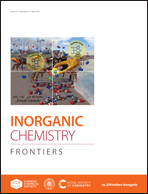Restricted active space simulations of the metal L-edge X-ray absorption spectra and resonant inelastic X-ray scattering: revisiting [CoII/III(bpy)3]2+/3+ complexes†
Abstract
The electronic structure of a compound plays a key role in its functionality and hence its applications. The core-level X-ray spectroscopy technique at the metal L-edge is widely used for probing the valence electronic structure. The X-ray spectral features in the metal L-edge energy regime are usually complicated by a multitude of interactions, which make them challenging to interpret. The X-ray absorption spectra (XAS) and the resonant inelastic X-ray scattering (RIXS) spectra in the cobalt L-edge energy regime of tris(2,2′-bipyridine) cobalt compounds [CoII(bpy)3]2+ and [CoIII(bpy)3]3+ are calculated using an ab initio restricted active space (RAS) approach. The experimental spectra are nicely reproduced and their spectral features are interpreted in terms of the orbital contributions and the final-state contributions. Unbiased assignments on the spin state of the ground state of these two cobalt compounds have been critically assessed through valence-excited state calculations and the fingerprints of the X-ray spectral features together with the calculations of the branching ratio.
![Graphical abstract: Restricted active space simulations of the metal L-edge X-ray absorption spectra and resonant inelastic X-ray scattering: revisiting [CoII/III(bpy)3]2+/3+ complexes](/en/Image/Get?imageInfo.ImageType=GA&imageInfo.ImageIdentifier.ManuscriptID=D0QI00148A&imageInfo.ImageIdentifier.Year=2020)


 Please wait while we load your content...
Please wait while we load your content...